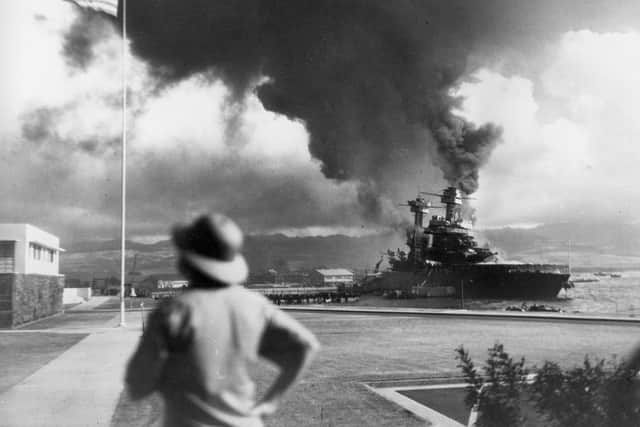Pearl Harbour hero tells his story of Japanese attack on first anniversary (1942)
and live on Freeview channel 276
The story was by Master Sergeant Willard Brame of Washington DC, “a Pearl Harbour hero” who was serving with the United States Forces in Northern Ireland.
For his part in the engagement he was favourably considered for the Good Conduct and Soldier's Medal.
Advertisement
Hide AdAdvertisement
Hide AdHe said: “I was awakened about 7.45am, I heard the noise of guns, but I thought that the shore batteries were practising. When I looked out of the window, though, I saw a flight of Japanese bombers, and flames coming from some of the ships in the harbour.


“It was like a nightmare. We did not expect an attack. The noise was awful. Bombs, machine guns, anti-aircraft guns were all going.
“We got about 16 men, and raced to the armaments shop, and the warehouses, and collected guns and ammunition. We filled trucks, and went out, with bombs to service bombers which were on the airfield. We were about halfway across when a flight of Japanese pursuit aircraft dived down and strafed us. We lay down.
“One of the shells touched off the fuse of a bomb in a truck, and blew up the lorry, killing the driver and his assistant.
Advertisement
Hide AdAdvertisement
Hide Ad“The noise was terrific, and we got into bombers which had been serviced and fired at the raiders until all our ammunition had been exhausted.


“Five of our men were killed. We then took cover in a ditch which had been dug for a pipe, and with rifles and machine guns we continued the fight.”
Brame continued: “Bombers were operating from about 10,000 feet. We heard an explosion, and saw the roof of the 8,000,000-dollar barracks, which accommodated about 5,000 men, going up in the air. Many of the men in the barracks were asleep when the attack came.
“Over in the harbour we could see smoke and flame coming from the ships. Anti-aircraft guns and machine guns were firing all over the place.
Advertisement
Hide AdAdvertisement
Hide Ad“Damaged Japanese machines were crashed by their pilots on to the roofs of hangars and into the barracks and assembly plant. Some of us crawled from the ditch and managed to pull four bombers out of a blazing hangar. We were commended for that.
“Altogether 54 Japanese aircraft were accounted for. We shot down five at Hickam Field.”